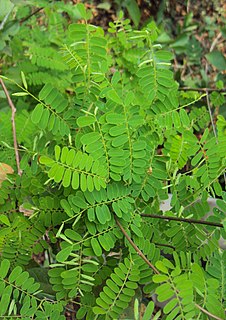
Dalbergia is a large genus of small to medium-size trees, shrubs and lianas in the pea family, Fabaceae, subfamily Faboideae. It was recently assigned to the informal monophyletic Dalbergia clade : the Dalbergieae. The genus has a wide distribution, native to the tropical regions of Central and South America, Africa, Madagascar and southern Asia.
Dalbergia baronii is a species of flowering plant in the legume family Fabaceae. It is endemic to Madagascar. It is named after the English missionary and botanist Rev. Richard Baron.
Dalbergia entadoides is a species of liana, found in Cambodia, Laos, Thailand and Vietnam: with the Vietnamese name trắc bàm. The genus Dalbergia is placed in the subfamily Faboideae and tribe Dalbergieae; no subspecies are listed in the Catalogue of Life.
Dalbergia monticola is a species of flowering plant in the legume family Fabaceae. It is endemic to Madagascar. It occurs at higher elevation, which gave the species its name.
Dalbergia pseudobaronii is a species of flowering plant in the legume family Fabaceae. It is endemic to Madagascar. Its leaves are similar to those of Dalbergia baronii, which gave the species its name.

Aeschynomene is a genus of flowering plants in the family Fabaceae, and was recently assigned to the informal monophyletic Dalbergia clade of the Dalbergieae. They are known commonly as jointvetches. These legumes are most common in warm regions and many species are aquatic. The genus as currently circumscribed is paraphyletic and it has been suggested that the subgenus Ochopodium be elevated to a new genus within the Dalbergieae, though other changes will also be required to render the genus monophyletic.

Corylus yunnanensis, the Yunnan hazel, is a species of hazelnut found in western China. It is a small tree or shrub. The flowers have triangular shaped petals. The round nuts which are encased in a very tough oval shaped shell and can be consumed by humans. The plant is not commercially grown for the nuts, rather they are sometimes used as ornamental plants. They are located in Western Guizhou, Hubei, South Western and Western Sichuan, and Western Yunnan.

The tribe Dalbergieae is an early-branching clade within the flowering plant subfamily Faboideae. Within that subfamily, it belongs to an unranked clade called the Dalbergioids. It was recently revised to include many genera formerly placed in tribes Adesmieae and Aeschynomeneae and to be included in a monophyletic group informally known as the dalbergioids sensu lato. The members of this tribe have a distinctive root nodule morphology, often referred to as an "aeschynomenoid" or "dalbergioid" nodule.

Dalbergia lanceolaria is a species of tree in the subfamily Faboideae and tribe Dalbergieae. It is a medium-sized tree growing to 20m tall and is native to: India, Sri Lanka, Nepal, Burma and Indo-China.

Dalbergia horrida is a species of thorny liana, with the Vietnamese name trắc nhiều hoa which is in the subfamily Faboideae and tribe Dalbergieae.
Dalbergia candenatensis is a species of liana, with the Vietnamese name trắc một hột. It is now placed in the subfamily Faboideae and tribe Dalbergieae; no subspecies are listed in the Catalogue of Life.
Dalbergia junghuhnii is a species of shrub placed in the subfamily Faboideae and tribe Dalbergieae; no subspecies are listed in the Catalogue of Life.
Dalbergia hancei is a species of liana, with the Vietnamese name (dây) trắc Hance. The genus Dalbergia is placed in the subfamily Faboideae and tribe Dalbergieae; no subspecies are listed in the Catalogue of Life.
Dalbergia spinosa is a species of thorny liana, with the Vietnamese name trắc gai. The genus Dalbergia is placed in the subfamily Faboideae and tribe Dalbergieae; no subspecies are listed in the Catalogue of Life.
Dalbergia rimosa is a species of liana, with the Vietnamese name trắc giây or trắc dây. The genus Dalbergia is placed in the subfamily Faboideae and tribe Dalbergieae.
Dalbergia parviflora is a species of liana found in South East Asia. Its name is kayu laka in Malay and Indonesian, khree in Thai, and in Vietnamese it is trắc hoa nhỏ. The heartwood of the plant is lakawood, an aromatic wood used for incense. The genus Dalbergia is placed in the subfamily Faboideae and tribe Dalbergieae; no subspecies are listed in the Catalogue of Life.
Dalbergia velutina is a species of liana. The genus Dalbergia is placed in the subfamily Faboideae and tribe Dalbergieae.
Dalbergia stipulacea is a species of small tree, with the Vietnamese name trắc lá bẹ. The genus Dalbergia is placed in the subfamily Faboideae and tribe Dalbergieae.
Dalbergia discolor is a species of liana, with the Vietnamese name trắc biến màu. The genus Dalbergia is placed in the subfamily Faboideae and tribe Dalbergieae; no subspecies are listed in the Catalogue of Life.
Pavieasia is a small genus of tree species in the family Sapindaceae. Records are mostly from southern China and Vietnam.




